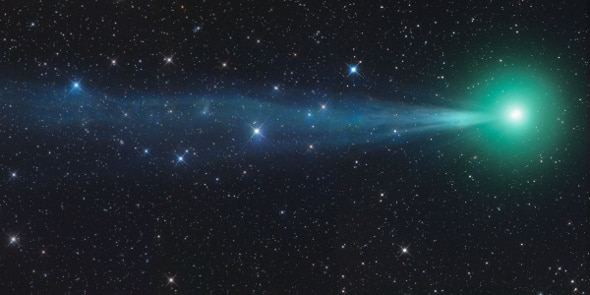Create a free profile to get unlimited access to exclusive videos, sweepstakes, and more!
Comet Lovejoy’s Tail, Flapping in the (Solar) Wind

Comet C/2014 Q2 (Lovejoy) is still doing its comet thing, orbiting the Sun and being all bright and gorgeous. It passed its closest approach to Earth last week, and is now starting to head out, away from both the Earth and Sun. It’ll start to fade, but for right now is still visible to the naked eye from dark locations. I’ve seen it several times with just binoculars; I wrote about this more over at my column for Sen.com (note: that requires a subscription, but Sen has a lot of great spacey news and info). I also have more info about Lovejoy in an earlier post here at Slate.
I’ve only glimpsed the brightest part of Lovejoy’s tail through binoculars. Deeper images taken by talented astrophotographers show it in all its glory: Millions of kilometers of extremely ethereal gas streaming off the comet’s nucleus, energized to glowing by sunlight, streamers and fans of gorgeous near-vacuum.
However, Lovejoy is so bright that the tail can be seen in short exposures. Jerry Lodriguss took advantage of this fact and shot 40 images of the comet on Jan. 11, 2015. He put them together to make this lovely animation of the comet’s motion over just an hour and a half:
How cool is that? (I urge you to see Lodriguss’s original MP4 animation; it’s higher resolution and looks terrific.) Look closely at the tail; you can see the bottom streamer moving up relative to the rest of the tail, and all the streamers appear to shift around.
That motion is real! The nucleus of the comet is the solid part, made up of a mixture of ices and rock. The comet is close enough to the Sun that the heat sublimates the ice, turning it directly into gas. That glows as it’s hit by solar ultraviolet light; the dominant color is green due to the presence of a carbon molecule.
The solar wind is made up of subatomic particles blown off by the Sun, and is flowing past the comet at high speed (generally hundreds of kilometers per second). This blows the gas away from the comet nucleus, creating the tail. That’s why the tail always points away from the Sun; it doesn’t just trail behind the comet.
The solar wind isn’t terribly steady. It has an embedded magnetic field, and it’s constantly roiling around as it moves away from the Sun. That’s why the tail of the comet changes. It’s showing us what the Sun’s solar wind is doing!
The tail is constantly changing. Sometimes the comet will discharge more gas if a pocket of ice near the surface vents, and the tail can grow in brightness and thickness. A big blast of solar wind can occur if the Sun’s magnetic activity gets feisty, and that can change the tail dramatically, sometimes disconnecting it from the comet entirely! Then, lizard-like, the comet grows another one. This happened to Lovejoy a few days ago, too. Bob King at Universe Today has more details on that event.
Astrophotographer Jeffrey Fisher sent me a note saying he caught the comet’s motion as well. His images aren’t as deep, but you can still see the green glowing head of the comet moving against the background stars.
It’s been cloudy and snowy here in Colorado the past few days, so I haven’t seen the comet at all. I hope we get clear skies so I can catch a glimpse of it again. It’s not often we get such a lovely visitor from the icy depths of the solar system, so it’s fun to go outside and see it. I highly recommend it.














